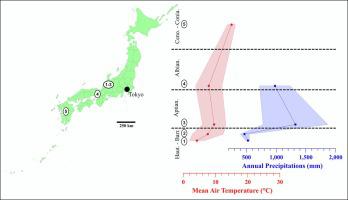当前位置:
X-MOL 学术
›
J. Asian Earth Sci.
›
论文详情
Our official English website, www.x-mol.net, welcomes your
feedback! (Note: you will need to create a separate account there.)
Paleoclimate and ecology of Cretaceous continental ecosystems of Japan inferred from the stable oxygen and carbon isotope compositions of vertebrate bioapatite
Journal of Asian Earth Sciences ( IF 2.7 ) Pub Date : 2021-01-01 , DOI: 10.1016/j.jseaes.2020.104602 Romain Amiot , Nao Kusuhashi , Haruo Saegusa , Masateru Shibata , Naoki Ikegami , Shizuo Shimojima , Teppei Sonoda , François Fourel , Tadahiro Ikeda , Christophe Lécuyer , Marc Philippe , Xu Wang
Journal of Asian Earth Sciences ( IF 2.7 ) Pub Date : 2021-01-01 , DOI: 10.1016/j.jseaes.2020.104602 Romain Amiot , Nao Kusuhashi , Haruo Saegusa , Masateru Shibata , Naoki Ikegami , Shizuo Shimojima , Teppei Sonoda , François Fourel , Tadahiro Ikeda , Christophe Lécuyer , Marc Philippe , Xu Wang

|
Abstract We investigated the environmental conditions that prevailed in continental ecosystems recorded in sedimentary deposits of Japan during the Cretaceous through the analysis of oxygen and carbon isotope compositions of phosphate (δ18Op) and apatite-bound carbonate (δ18Oc and δ13Cc) of vertebrate teeth and bones. Local surface water δ18Ow values were calculated using known phosphate-water isotope fractionation equations. Anomalously low δ18Ow values of local waters strongly suggest a significant contribution of high-altitude precipitation from nearby mountains to local surface waters. Mean air temperatures were estimated using a global meteoric water δ18Omw value – Mean Annual Air Temperature relationship, and compared to surface water temperatures estimated from fish apatite δ18Op values. Local mean annual precipitations (MAP) were estimated using the known relationship existing between MAP and C3 plant δ13Cp value, the latter being calculated using apatite-diet 13C-enrichment applied to plant-eating sauropod and ornithopod dinosaur δ13Cc values. Reconstructed environmental conditions suggest that climate changed from cool temperate to warm temperate, being relatively cold and dry during the Late Hauterivian and Barremian to warmer and seasonally more humid during the Aptian and Albian, and even warmer during the Cenomanian-Coniacian. Proposed thermal evolution during the Early Cretaceous is compatible with the absence of thermophilic taxa such as crocodylomorphs before the Aptian in the fossil record of Japan.
中文翻译:

从脊椎动物生物磷灰石的稳定氧和碳同位素组成推断日本白垩纪大陆生态系统的古气候和生态
摘要 我们通过分析脊椎动物牙齿和骨骼的磷酸盐 (δ18Op) 和磷灰石结合碳酸盐 (δ18Oc 和 δ13Cc) 的氧和碳同位素组成,研究了白垩纪日本沉积矿床中记录的大陆生态系统中普遍存在的环境条件。使用已知的磷酸盐-水同位素分馏方程计算当地地表水 δ18Ow 值。当地水域异常低的 δ18Ow 值强烈表明附近山区的高海拔降水对当地地表水有显着贡献。平均气温是使用全球大气水 δ18Omw 值 - 平均年气温关系估算的,并与根据鱼类磷灰石 δ18Op 值估算的地表水温度进行比较。当地年平均降水量 (MAP) 使用 MAP 和 C3 植物 δ13Cp 值之间存在的已知关系进行估计,后者是使用磷灰石饮食 13C 富集应用于食植物蜥脚类恐龙和鸟脚类恐龙 δ13Cc 值计算的。重建的环境条件表明气候从凉爽的温带转变为暖温带,从晚欧特里维阶和巴雷米亚期的相对寒冷干燥到阿普梯阶和阿尔比阶的温暖和季节性更潮湿,甚至在森诺曼阶-康尼亚阶期更加温暖。提出的早白垩世热演化与日本化石记录中在 Aptian 之前没有嗜热类群(如鳄鱼形)相一致。后者是使用磷灰石饮食 13C 富集计算的,适用于食植物的蜥脚类恐龙和鸟脚类恐龙 δ13Cc 值。重建的环境条件表明气候从凉爽的温带转变为暖温带,从晚欧特里维阶和巴雷米亚期的相对寒冷干燥到阿普梯阶和阿尔比阶的温暖和季节性更潮湿,甚至在森诺曼阶-康尼亚阶期更加温暖。提出的早白垩世热演化与日本化石记录中在 Aptian 之前没有嗜热类群(如鳄鱼形)相一致。后者是使用磷灰石饮食 13C 富集计算的,适用于食植物的蜥脚类恐龙和鸟脚类恐龙 δ13Cc 值。重建的环境条件表明气候从凉爽的温带转变为暖温带,从晚欧特里维阶和巴雷米亚期的相对寒冷干燥到阿普梯阶和阿尔比阶的温暖和季节性更潮湿,甚至在森诺曼阶-康尼亚阶期更加温暖。提出的早白垩世热演化与日本化石记录中没有阿普蒂安之前的鳄鱼形等嗜热分类群是一致的。在晚 Hauterivian 和 Barremian 期间相对寒冷和干燥,在 Aptian 和 Albian 期间温暖和季节性更潮湿,在 Cenomanian-Coniacian 期间甚至更温暖。提出的早白垩世热演化与日本化石记录中在 Aptian 之前没有嗜热类群(如鳄鱼形)相一致。在晚 Hauterivian 和 Barremian 期间相对寒冷和干燥,在 Aptian 和 Albian 期间温暖和季节性更潮湿,在 Cenomanian-Coniacian 期间甚至更温暖。提出的早白垩世热演化与日本化石记录中在 Aptian 之前没有嗜热类群(如鳄鱼形)相一致。
更新日期:2021-01-01
中文翻译:

从脊椎动物生物磷灰石的稳定氧和碳同位素组成推断日本白垩纪大陆生态系统的古气候和生态
摘要 我们通过分析脊椎动物牙齿和骨骼的磷酸盐 (δ18Op) 和磷灰石结合碳酸盐 (δ18Oc 和 δ13Cc) 的氧和碳同位素组成,研究了白垩纪日本沉积矿床中记录的大陆生态系统中普遍存在的环境条件。使用已知的磷酸盐-水同位素分馏方程计算当地地表水 δ18Ow 值。当地水域异常低的 δ18Ow 值强烈表明附近山区的高海拔降水对当地地表水有显着贡献。平均气温是使用全球大气水 δ18Omw 值 - 平均年气温关系估算的,并与根据鱼类磷灰石 δ18Op 值估算的地表水温度进行比较。当地年平均降水量 (MAP) 使用 MAP 和 C3 植物 δ13Cp 值之间存在的已知关系进行估计,后者是使用磷灰石饮食 13C 富集应用于食植物蜥脚类恐龙和鸟脚类恐龙 δ13Cc 值计算的。重建的环境条件表明气候从凉爽的温带转变为暖温带,从晚欧特里维阶和巴雷米亚期的相对寒冷干燥到阿普梯阶和阿尔比阶的温暖和季节性更潮湿,甚至在森诺曼阶-康尼亚阶期更加温暖。提出的早白垩世热演化与日本化石记录中在 Aptian 之前没有嗜热类群(如鳄鱼形)相一致。后者是使用磷灰石饮食 13C 富集计算的,适用于食植物的蜥脚类恐龙和鸟脚类恐龙 δ13Cc 值。重建的环境条件表明气候从凉爽的温带转变为暖温带,从晚欧特里维阶和巴雷米亚期的相对寒冷干燥到阿普梯阶和阿尔比阶的温暖和季节性更潮湿,甚至在森诺曼阶-康尼亚阶期更加温暖。提出的早白垩世热演化与日本化石记录中在 Aptian 之前没有嗜热类群(如鳄鱼形)相一致。后者是使用磷灰石饮食 13C 富集计算的,适用于食植物的蜥脚类恐龙和鸟脚类恐龙 δ13Cc 值。重建的环境条件表明气候从凉爽的温带转变为暖温带,从晚欧特里维阶和巴雷米亚期的相对寒冷干燥到阿普梯阶和阿尔比阶的温暖和季节性更潮湿,甚至在森诺曼阶-康尼亚阶期更加温暖。提出的早白垩世热演化与日本化石记录中没有阿普蒂安之前的鳄鱼形等嗜热分类群是一致的。在晚 Hauterivian 和 Barremian 期间相对寒冷和干燥,在 Aptian 和 Albian 期间温暖和季节性更潮湿,在 Cenomanian-Coniacian 期间甚至更温暖。提出的早白垩世热演化与日本化石记录中在 Aptian 之前没有嗜热类群(如鳄鱼形)相一致。在晚 Hauterivian 和 Barremian 期间相对寒冷和干燥,在 Aptian 和 Albian 期间温暖和季节性更潮湿,在 Cenomanian-Coniacian 期间甚至更温暖。提出的早白垩世热演化与日本化石记录中在 Aptian 之前没有嗜热类群(如鳄鱼形)相一致。











































 京公网安备 11010802027423号
京公网安备 11010802027423号